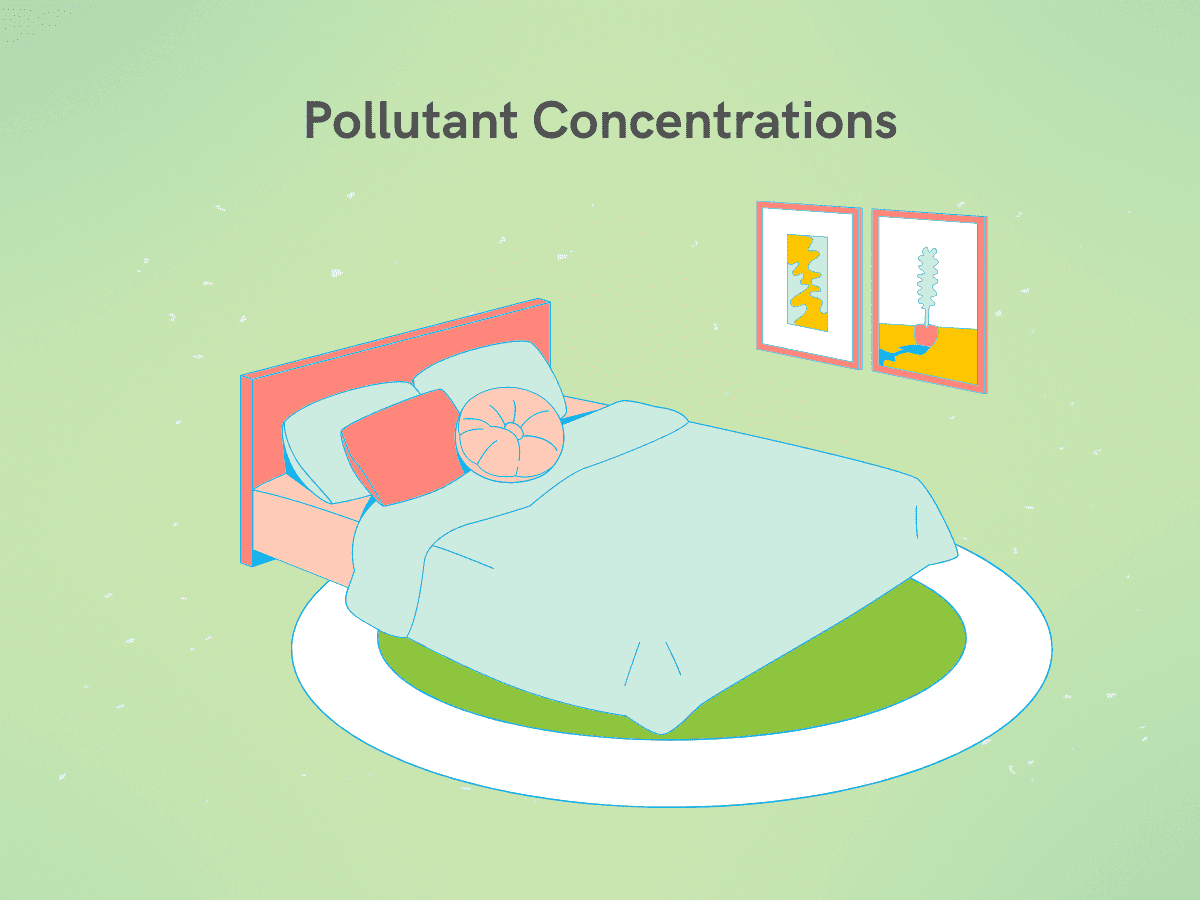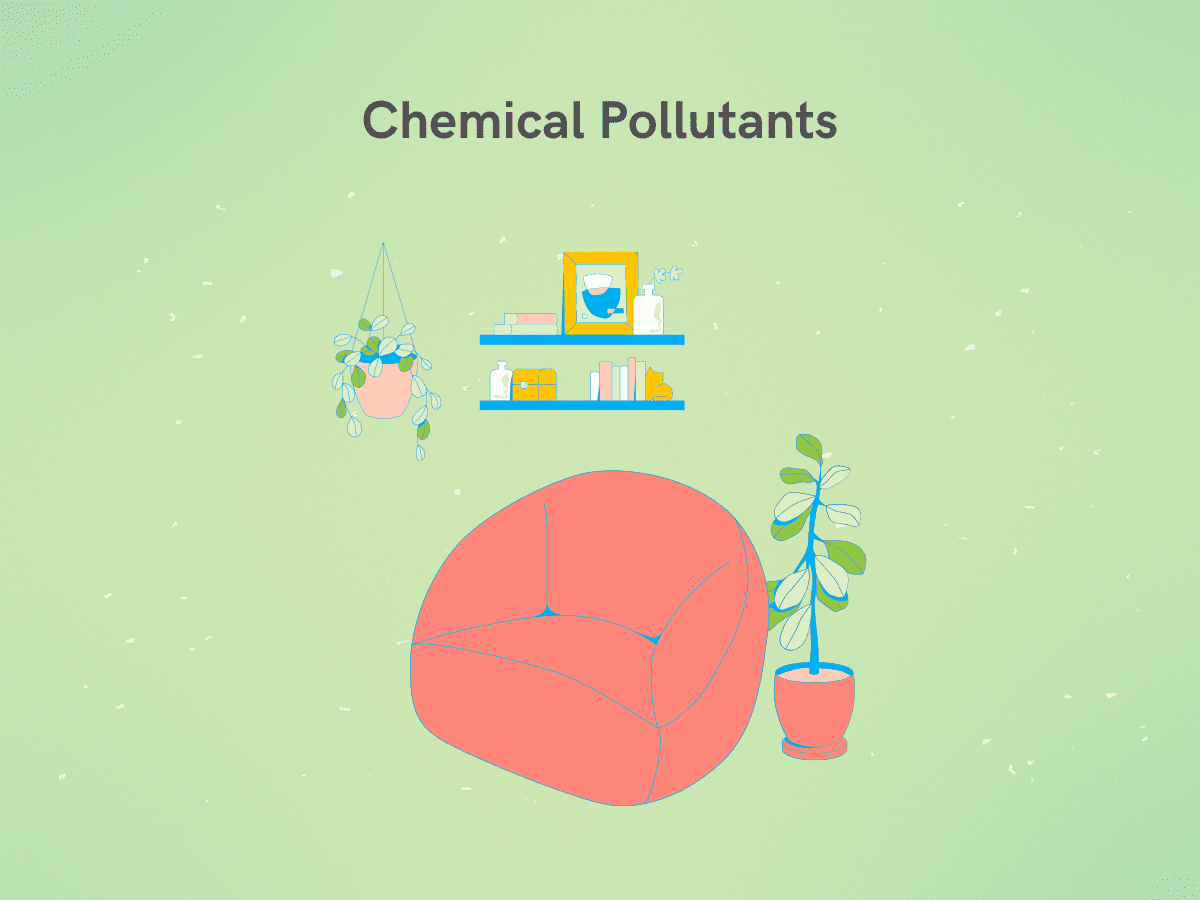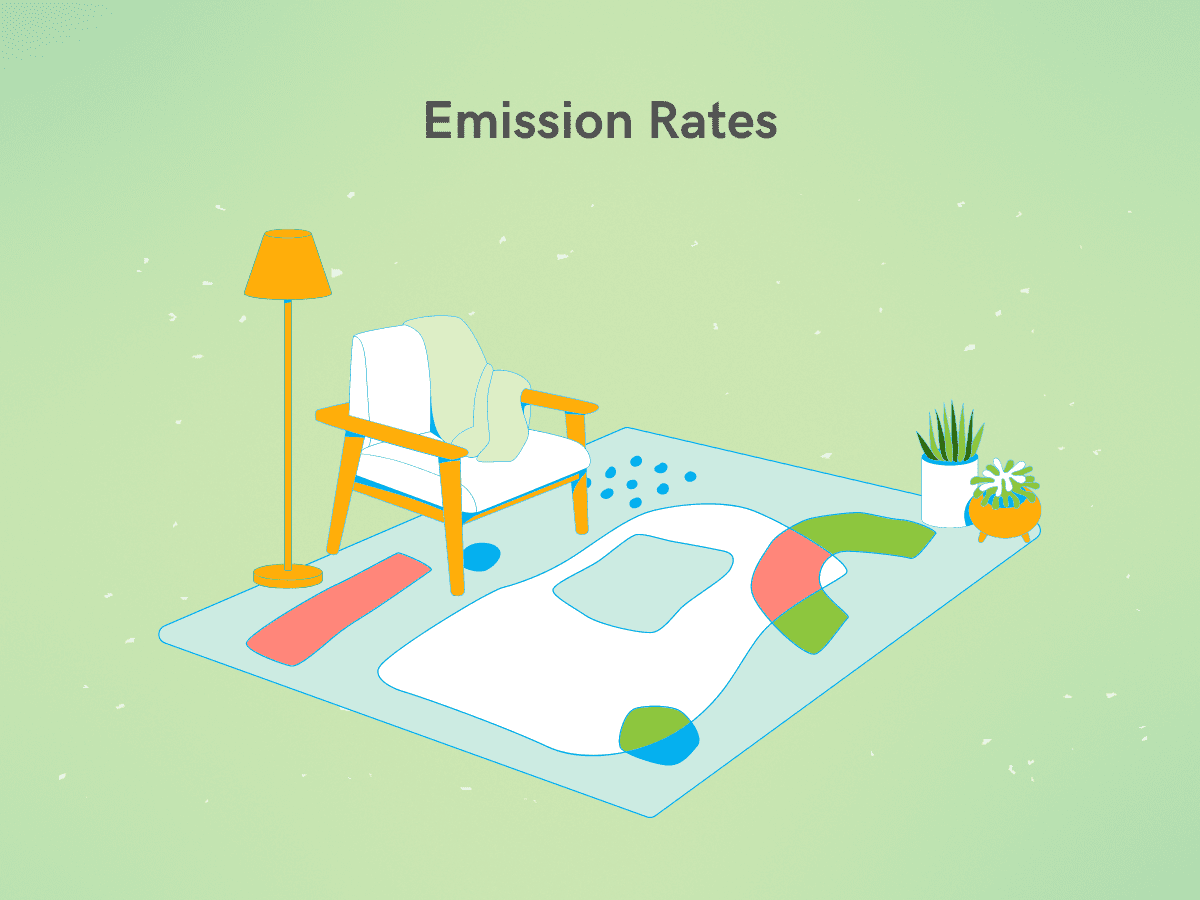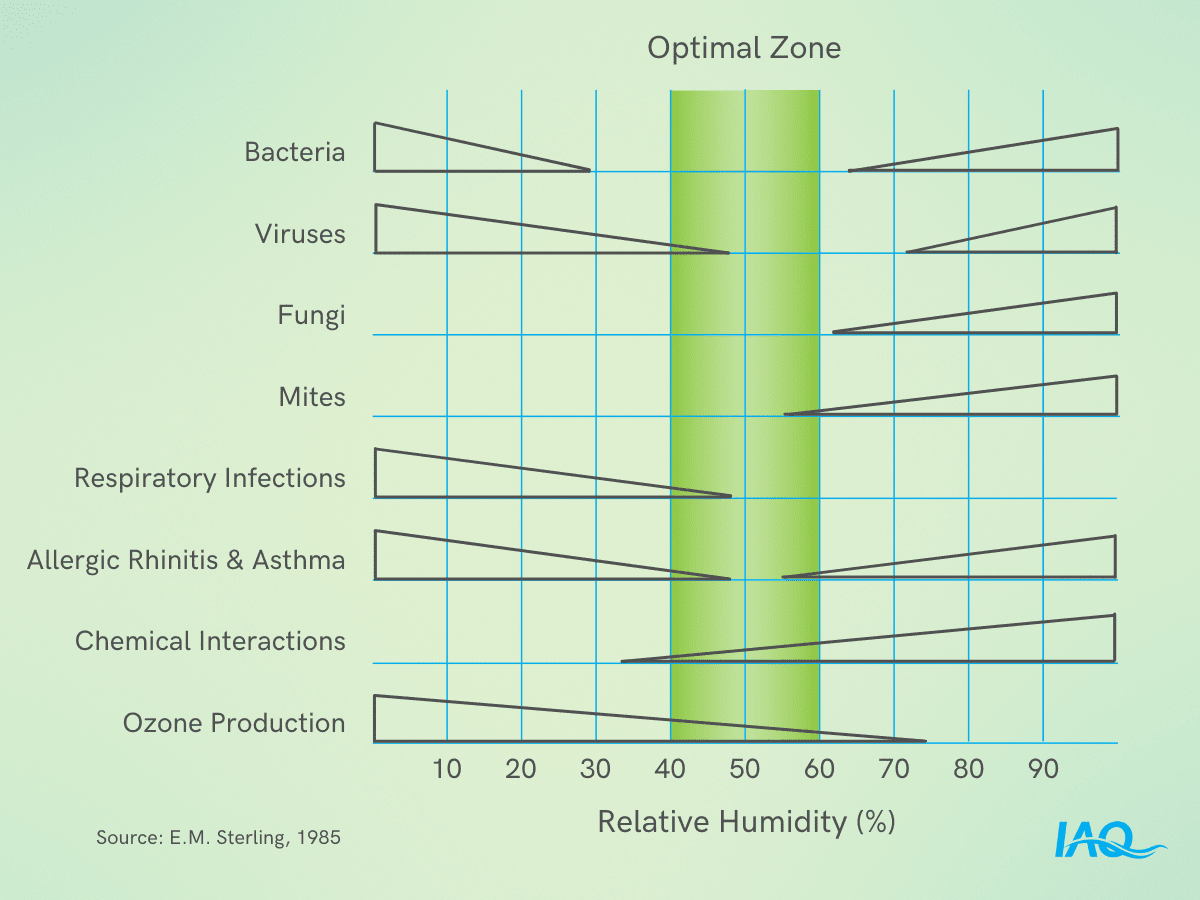When it comes to the indoor environment, everything is connected. Similar to the outdoor environment, the indoors is its own complex interrelated ecosystem. Two key factors in this indoor ecosystem are moisture and air. Or more specifically, humidity and indoor air quality.
Air is made up of many different gases including water vapor, which is water in its gaseous form. Water vapor is always present in the air. Aside from perhaps extremely controlled experiential spaces, air can never be entirely devoid of moisture.
While water vapor is always in the air, the amount of water vapor present isn’t a static number. Instead, it fluctuates. And the amount of moisture present in indoor air is an important factor that significantly affects the health and comfort of that indoor space. In this article, we break down how exactly indoor air’s moisture level affects indoor air quality.
4 Ways Home Humidity Levels Affect IAQ
Humidity has both a direct and indirect effect on the indoor environment and home quality. Likewise, humidity has both direct and indirect effects on human health.
The direct effects of home humidity levels are apparent: it affects occupant comfort.
The indirect effects of home humidity levels aren’t quite as straightforward. These indirect effects stem from humidity’s interactions with indoor air pollutants.
In other words, the best way to understand how humidity levels indirectly impact the quality of indoor spaces and human health is through the relationship between humidity and indoor air quality. Let’s dive in!
 More: If you’re looking for ways to know if your home humidity levels are too high or too low, we’ve got you covered. Here are a handful of key signs, symptoms and factors to tell if your home’s humidity levels are outside of the ideal range! →
More: If you’re looking for ways to know if your home humidity levels are too high or too low, we’ve got you covered. Here are a handful of key signs, symptoms and factors to tell if your home’s humidity levels are outside of the ideal range! →Indoor Humidity Explained
If you have a general understanding of humidity, feel free to skip this section. Otherwise, we offer a super quick and basic indoor humidity lesson.
As mentioned earlier, water vapor (in its gaseous state) is always present in the air. This is what is known as humidity.
A simple rule of thumb … the more water vapor in the air, the higher the humidity level. The less water vapor in the air, the lower the humidity level.
When people talk about indoor humidity, they’re more often referring to indoor relative humidity (RH). Relative humidity is a measurement of the amount of water vapor present in a given volume of air at a specific temperature, compared to the total amount of water vapor possible in that given volume of air at the same temperature. Translation: it is the indoor humidity level relative to the temperature. This measurement is expressed as a percentage. It differs from absolute humidity, which measures the amount of water vapor in the air, regardless of temperature.
With that lesson down, let’s dive into how humidity levels affect indoor air quality.
1. Indoor Humidity Levels Can Increase Pollutant Concentrations

One of the main ways humidity affects indoor air quality is by directly affecting indoor air pollutants. The amount of water vapor in the air can increase or decrease pollutant concentrations. Whether or not an airborne contaminant is a problem in your home partially depends on your home’s humidity level!
Many indoor air pollutant concentrations depend on the temperature and humidity level indoors. How it works exactly—as in which humidity level will influence pollutant concentrations, and the humidity level that will control and prevent increased pollutants—is pollutant specific.
Excessive indoor dampness also degrades materials over time, worsening indoor air pollution.
Research has also shown that higher relative humidity levels lead to increasingly irritating odors, particles and vapors indoors. In other words, excessive indoor moisture quite literally reduces occupant comfort by worsening indoor air quality.
This may make water vapor seem like a pollutant … but that’s not quite the best way to view it. Water is and always will be present in the air. It itself is not a contaminant.
The amount of water vapor present affects how contaminants function indoors. Humidity itself is not an indoor air pollutant. It is critical to control humidity levels indoors, just like anything else in the indoor environment, but as an influential parameter and less as a source.
Why It Matters
- Indoor air pollutants affect occupants’ quality of life. Indoor air pollutants affect human comfort, health and wellness in the now and the long term. Indoor air pollutants also impact productivity, mental ability, mental health and concentration to name a few. For this reason, anything that influences the concentration level of pollutants and therefore our exposure level to them, matters.
2. Home Humidity Levels Affect Chemical Pollutants

Chemical pollutants are one type of indoor air pollutant affected by humidity. Chemical pollutants include volatile organic compounds (VOCs), ozone, environmental tobacco smoke, radon and more.
Not only does the air’s moisture level influence chemical pollutants concentrations, but it can also create new ones. Chemicals and water vapor can interact to form both respiratory and dermal irritants. As an example, water vapor combines with sulfur dioxide to form sulfuric aerosols, salts and acids.
Research shows that chemical interactions in indoor air start to increase around 30% RH, but truly become a problem above 50% RH. One key chemical pollutant exception to this higher RH problem level is ozone. Ozone production actually increases at lower relative humidity levels.
Why It Matters
- Chemical pollutants negatively affect human health. Chemical pollutants’ symptoms and health effects vary widely, as does the onset time. Sometimes health problems, like upper respiratory symptoms after exposure to tobacco smoke, occur in the short term. Other times the effects aren’t until much later, such as radon-related lung cancer years after exposure. Regardless, regulating indoor humidity levels mitigates exposure to airborne chemical pollutants indoors.
3. Humidity Affects Emission Rates

VOCs are a type of chemical pollutant. A number of materials, products, and furnishings emit VOCs. Indoor moisture levels influence these emission rates, also known as off-gassing rates.
High humidity levels make VOC emissions, and therefore indoor air quality, worse in two ways. Higher humidity levels quite literally increase the ‘emittability’ of materials and the rate at which those materials emit pollutants. For example, formaldehyde emission rates are higher when the indoor relative humidity level is higher.
Worsening emission rates is a key aspect of the humidity and indoor air quality relationship that’s important for homeowners to be aware of.
Why It Matters
- VOC exposure contributes to a number of adverse health effects. VOC-related health symptoms include headaches, nausea and eye, nose and throat irritation. The negative health effects include liver damage, central nervous system issues, and increased cancer risk. VOCs are in thousands of household products and materials, including everyday-use products. In modern society, we are continuously exposed to volatile organic compounds. This reality doesn’t mean that all exposure is equal. Dosage or concentration level and exposure time are significant; therefore, controlling anything that increases our exposure to VOCs is essential!
4. Home Humidity Levels Affect Biological Pollutants

Another big category of indoor air pollutants is biological pollutants. Biological pollutants include bacteria, viruses, fungi, mites, mold and other organisms.
Humidity plays a major role in this pollutant category. The organisms’ survival and rate of growth and reproduction are determined by the indoor moisture level. Moisture is therefore a key factor in biological contaminant’s presence or absence indoors.
Indoor humidity levels affect the potential growth of microorganisms on building surfaces, the potential for bioaerosols, pests’ ability to survive and spread, mold growth and infectious pathogens’ survival and circulation indoors.
They also have varying ideal humidity control ranges. Not only between different categories such as fungi and bacteria but even within a pollutant category such as viruses. For instance, viruses like influenza and measles prefer less than 50% RH, while viruses like polio and herpes spread best above 50% RH.
Why It Matters
- Bacteria and viruses commonly result in respiratory infections. 40–50% RH is the ideal range to prevent respiratory infections. Why? It’s the middle ground among many different kinds of infectious bacteria and viruses that survive in either extremely high or extremely low humidity levels. Additionally, a higher relative humidity level has shown to reduce susceptibility to illness because it keeps the nose and throat mucous membranes moist. It’s thought that mucus prevents infectious aerosols from entering the lungs. Also notable, higher relative humidity levels increase the rate at which aerosols settle on surfaces and fall out of the air, reducing human exposure to airborne disease and infection indoors.
- Biological pollutants are common allergens and asthma triggers. High indoor humidity enables mold and bacteria growth, pests and mites. For this reason, 40–60% RH has also been proven to be the best humidity range for asthmatics and allergy sufferers. Ensuring the ideal mid-range reduces the number of allergens and asthma triggers present in the home in the first place, thus reducing attacks and symptoms too!
- Biological pollutants impact occupant comfort. After all, higher humidity levels enable the growth and spread of biological contaminants. That means an increased potential for mold and mildew indoors, and pests like cockroaches and dust mites which no one wants in their living space!
What Is The Healthiest Humidity Level for a Home?
The healthiest home humidity level is 40–60% RH. But how did experts arrive at this ideal range?
One thing should be clear: extreme indoor humidity levels, whether super high or super low, can have detrimental effects on human health and home quality.
 More: Common questions about indoor humidity levels, key reasons the 40–60% range is ideal and how to ensure healthy home humidity ➜
More: Common questions about indoor humidity levels, key reasons the 40–60% range is ideal and how to ensure healthy home humidity ➜Still, choosing an ideal indoor humidity level is difficult because each indoor pollutant thrives at a specific moisture level; meaning there is a different ideal humidity level to control each indoor pollutant.
The healthiest home humidity level should accomplish three things:
- It should feel comfortable to occupants.
- It should minimize the growth and spread of organisms, pathogens and other biological pollutants.
- It should minimize the emission of chemicals, the rate that materials off-gas and the formation and interaction of pollutants indoors.
In order to accomplish all three goals, the best approach is to find the average of each individual pollutant’s ideal control humidity level. Thankfully, researchers have done just that.
In fact, a 1985 study reviewed the best humidity levels for various pollutants and developed a chart that helps visualize the optimum zone. Known as the Sterling Chart, it effectively illustrates how various indoor relative humidity levels affect indoor air pollutants and the resulting health effects.

It’s clear that the 40–60% RH range best minimizes biological pollutants’ growth, pathogens’ spread indoors, off-gassing rates and chemical interactions indoors. And it does so while maintaining occupant comfort!
Indoor Air Quality and Humidity
Understanding the relationship between humidity and indoor air quality is necessary to better understand why controlling humidity levels in your home is so important. The how is actually the easier part! There are whole-home humidity control solutions available that help regulate and maintain the ideal indoor humidity level.
Humidity and air are consistently interacting with one another in every indoor space. Take the guesswork out of humidity and indoor air quality. Take charge of your home’s humidity levels!
 More: Choosing a whole-home humidifier, how to choose between an evaporative humidifier and a steam humidifier. Read ➜
More: Choosing a whole-home humidifier, how to choose between an evaporative humidifier and a steam humidifier. Read ➜



